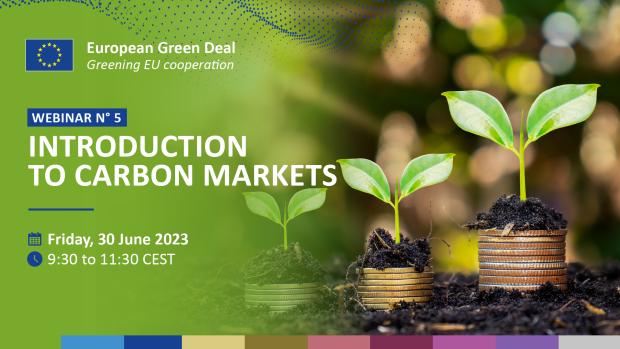Webinar: Introduction to Carbon Markets
INTPA & NEAR
Event details
Description

Objectives of the course
The EU has a leading role in the fight against climate change and, consequently, the implementation of the Paris Agreement. The Paris Agreement sets out a global action plan to limit global warming to 1.5°C, at the very least well below 2°C. Carbon pricing is a cost-effective policy tool that governments can use as part of their broader climate strategy to achieve these goals. By incorporating climate change costs into economic decision-making, carbon pricing can help encourage changes in production, consumption, and investment patterns, thereby underpinning low-carbon growth. Governments can price carbon using a variety of policy instruments, of which carbon taxation, emission trading systems (ETS) and carbon crediting mechanisms are the best known examples. At the international level, through Article 6 of the Paris Agreement, countries have agreed to use carbon pricing as part of their “cooperative approaches” for governments and the private sector. In addition, voluntary carbon standards, based on certification of carbon credits by private certifiers, are accessible to companies and individuals alike..
Prices in carbon taxes and ETSs are increasing since 2021 across multiple jurisdictions, driven by more ambitious climate policies, as well as broader economic factors such as global energy commodity prices. The rapid rise in ETS carbon prices and the finalisation of the Article 6 Rulebook have created a rapidly growing interest in carbon markets in partner countries.
This webinar aims at discussing different types and examples of carbon pricing mechanisms, the current status of relevant markets and mechanisms as well as the role that the EU Commission and delegations can play to seize the opportunities and manage the risks attached to market and non-market carbon pricing mechanisms.
Finally, this webinar will address the importance of the forest sector in the fight against climate change, in particular in relation to challenges and opportunities to attract finance by partner countries.
The specific objectives of this webinar are:
- Enhance understanding of different carbon pricing options: concepts, definitions, objectives, application, and examples.
- Update on the structure and current status of different markets, with a focus on markets accessible to developing countries and their private and public sector.
- Share opportunities, challenges and risks associated to certain carbon pricing mechanisms.
- Enhance understanding on the mechanisms under Article 6 of the Paris Agreement: background, status, challenges and options for support.
- Update on opportunities to attract finance in the forest and REDD+ sector
Content
The webinar will cover:
- Carbon pricing mechanisms such as emission trading systems, carbon taxation and carbon credit mechnanisms at country, subnational and project levels
- Compliance and voluntary carbon markets, including their interactions and current trends.
- Opportunities, risks and challenges related to carbon pricing mechanisms
- The EU position regarding certain mechanisms and initiatives
- The Paris Agreement Article 6, opportunities, risks, rules and potential needs for support
- Examples of EU actions on carbon pricing, lessons learned
Target audience
Open to all EU staff working in EU Delegations or Headquarters. In particular, those who are not working in the environment and climate change sectors are encouraged to participate.
Registrations
You can click here to register via EU Learn (only for EU staff).
For more EU trainings and webinars click here
Related documents
Webinar on Carbon Market - PPT2
English (5.3 MB - PDF)
Log in with your EU Login account to post or comment on the platform.